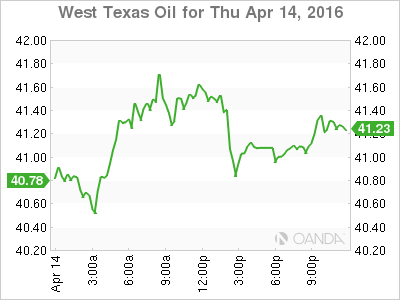The Canadian dollar retraced on Thursday as energy prices traded lower ahead of the Doha oil output freeze summit over the weekend. Yesterday the Bank of Canada (BoC) held rates unchanged at 0.50 percent and issued words of caution. The BoC did not make any dovish comments, and in general outlined the risk factors facing the Canadian economy. The central bank will stand on the sidelines until the effects of the federal budget announced last month starts to have economic impact.
Canada’s new home prices were up by 0.2% in February compared to the previous month. The rise in house prices in major markets beat expectations as Toronto and Vancouver had a big jump despite energy dependant cities dropping.
U.S. economic indicators have disappointed this week writes OANDA’S MP Kenny Fisher:
US inflation indicators continue to point to a soft inflation picture. CPI and Core CPI, key gauges of consumer inflation, posted small gains of 0.1%. The Core CPI release was particularly disappointing, coming after two consecutive gains of 0.3%. The weak inflation numbers will make it difficult to make a case for raising interest rates in the first half of 2016 and bolsters the dovish position of Janet Yellen and her supporters. Deustche Bank analyst Brett Ryan summed up the soft US inflation picture, noting that “we’re still importing deflation from other areas of the world”. There was much better news on the employment front, as Unemployment Claims fell to 253 thousand, its lowest weekly reading since March 1973. This release is another confirmation of a robust US labor market.
US retail sales reports, a key measure of consumer spending, disappointed in March. Core Retail Sales improved to 0.2%, but fell short of the forecast of 0.4%. Retail Sales surprised with a decline of 0.3%, shy of the estimate of a 0.1% gain. It marked the second straight drop for the indicator. Consumer spending represents the biggest part of the economy, so these figures could spell trouble at a time that the export sector remains soft due to weak global demand. PPI, a key gauge of inflation in the manufacturing sector, continues to struggle, posting a third decline in four months. The index dipped 0.1%, well off the estimate of a 0.3% gain.

The USD/CAD appreciated 0.3 percent in the last 24 hours. The pair traded near the 1.29 price level before setting at 1.2854. The price of Brent fell 0.20 percent and WTI was flat giving little support for the loonie. The USD has risen after slow global fears have subsided and the employment data boosted the impressive recovery in that important pillar.

Oil had a volatile session as supply numbers continue to pressure downwards while the Organization of the Petroleum Exporting Countries (OPEC) and Russia’s upcoming Doha oil price summit has kept the price from falling further. The International Energy Agency said earlier today that freezing will not have a lasting impact on prices as supplies are still large. Saudi Arabia has dismissed the possibility of a cut, and has even reduced the chances of a freeze agreement if certain OPEC members don’t limit their output. Given the lack of trust amongst producers a deal will be a good sign, but will play out as described by the IEA.
The CAD will close out the week by releasing the manufacturing sales data on Friday. The forecasts call for a 1.4 percent contraction as even a lower currency has not been able to build a consistent positive trend for manufacturing and some backlash is expected after last month record setting 2.3 percent growth in January.
CAD events to watch this week:
Friday, April 15
8:30am CAD Manufacturing Sales m/m
10:00am USD Prelim UoM Consumer Sentiment
